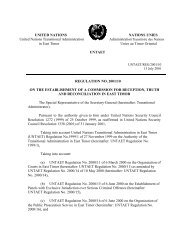The Srebrenica Massacre - Nova Srpska Politicka Misao
The Srebrenica Massacre - Nova Srpska Politicka Misao
The Srebrenica Massacre - Nova Srpska Politicka Misao
Create successful ePaper yourself
Turn your PDF publications into a flip-book with our unique Google optimized e-Paper software.
<strong>The</strong> Numbers Game<br />
mate for the total number of victims to be only slightly higher, 7,536” (p. 244).<br />
3 As recently as the July 2008 arrest of former Bosnian Serb President Radovan<br />
Karadzic in Belgrade, the U.K. media especially resorted to the 250,000 figure.<br />
See, e.g., Shan Ross, “Serb leader Karadzic held after more than a decade on the<br />
run,” <strong>The</strong> Scotsman, July 22, 2008; Janine di Giovanni, “Spectres of Sarajevo:<br />
News of the arrest conjures memories of those dreadful days of death. Next, for<br />
Mladic,” <strong>The</strong> Guardian, July 23, 2008; Ian Bruce, “Ultra-nationalist beginnings<br />
that led to a brutal and disastrous conflict,” <strong>The</strong> Herald, July 23, 2008; and<br />
“Genocide’s legacy in Bosnia, Darfur,” Editorial, Toronto Star, July 23, 2008.<br />
Richard Holbrooke, the former lead U.S. negotiator for Bosnia - Herzegovina in<br />
1995, used the phrase “nearly 300,000” in a commentary he wrote at the same<br />
time: “<strong>The</strong> Face of Evil,” Washington Post, July 23, 2008.<br />
4 As early as the negotiations that began in Geneva on January 2, 1993, the Bosnian<br />
Muslim President Alija Izetbegovic warned of 200,000 dead (and tens-ofthousands<br />
of women raped); several days later, speaking outside the United<br />
Nations in New York, Izetbegovic repeated this warning. See Juliajana Mojsilovic,<br />
“Peace Talks Recessed; Mediators Say Serbs Hold Up Deal,” Associated Press,<br />
January 4, 1993; Anthony Goodman, “Bosnian leader evokes memories of Munich<br />
appeasement,” Reuters, January 7, 1993; and Barry Schweid, “Bosnian<br />
Leader Appeals for U.S. Support,” Associated Press, January 8, 1993.<br />
5 See the entry for “United Kingdom and Colonies,” the “1939-1945 War,” in<br />
“Breakdown of Numbers of War Dead by Forces,” a PDF maintained by the<br />
Commonwealth War Graves Commission, United Kingdom,<br />
.<br />
6 Ewa Tabeau and Jakub Bijak, “War-related Deaths in the 1992-1995 Armed Conflicts<br />
in Bosnia and Herzegovina: A Critique of Previous Estimates and Recent Results,”<br />
European Journal of Population, Volume 21, 2005, pp. 187-215; here p.<br />
207. At the time, Tabeau - Bijak worked for the Demographic Unit of the Office<br />
of the Prosecutor, the International Criminal Tribunal for the former Yugoslavia<br />
(ICTY).<br />
7 Ibid. Using the data in Tabeau - Bijak, it seems the ethnic breakdown of the estimated<br />
total is 60% Muslims, 29% Serbs, 7% Croats and 4% “others” (comprising<br />
mostly Roma and those who declared themselves to be “Yugoslavs”). One<br />
should bear in mind that, despite being almost entirely ignored in the standard<br />
version of events, a significant number of Muslims in the Bihac area of western<br />
Bosnia followed the leadership of the independent Bosnian Muslim Fikret Abdic,<br />
and his force of 5,000 fought against the Sarajevo-controlled Bosnian Muslim<br />
Army.<br />
8 Ibid. See Table 5, “Minimum war-related deaths by ethnicity, status as of mid-<br />
2003,” p. 204. Out of a minimum 45,980 war-related Bosnian Muslim deaths,<br />
23,755 (51.66 percent) were soldiers at the time of death, and 22,225 (48.33<br />
percent) civilians.<br />
143



